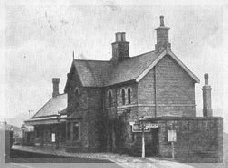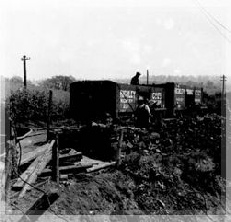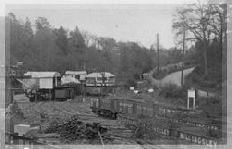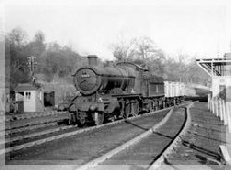|
Railways of Highley Today Highley is perhaps best known as a station on the Severn Valley Railway (SVR) (Fig 1). However the village has a long industrial history and the remains of numerous railways and tramways can be seen today. At the end of the 18th century coal mines and a blast furnace were opened in the nearby parish of Billingsley. The coal and iron were brought alongside the Borle Brook through Highley by a horse-worked tramway to the River Severn where they were sent downstream in boats. This tramway worked for no more than 15 years, but its route can still largely be traced as a footpath alongside the Borle Brook, running via shallow embankments and cuttings. A little later the Stanley Colliery (1804-1823) opened close to the site of the present Highley Station and this was also served by tramways, as were the numerous sandstone quarries by the river. When the Severn Valley Railway was opened in Highley in 1862, there was little or no industrial activity and the station was designed to serve an agricultural village. Construction of the railway through Highley was difficult and the alignment of the line had to be changed to avoid unstable ground. In 1878 the Highley Mining Company began to sink for coal just to the west of the station and when this was struck the next year the Company realised they needed a rail link. A self-acting, rope-worked incline was built to link the mine and the railway and this is now the main path from the Highley site of the Severn Valley Country Park to the SVR (Fig 2). More substantial railways followed, to link the SVR with coal mines at Kinlet in the 1890s and Billingsley in 1913. Both of these were standard gauge, locomotive-worked lines (Fig 3). They followed the Borle Brook but on the opposite bank to the 18th century tramway. Much of the Billingsley line is now a public footpath; the stretch from Billingsley to New England in Highley forms part of the Jack Mytton Way, a long-distance bridle way. Although initially separate, the Billingsley and Kinlet railways were later connected and worked until the closure of Kinlet Colliery in 1937. The Alveley Colliery of 1935-1969 also needed a rail connection. Here the Highley Mining Company built a rope-worked tramway from the mine in Alveley, crossing the Severn on a bridge to reach an unloading terminus on the SVR at Alveley Sidings (Fig 4). The latter is now the site of the Country Park Halt on the SVR and the tramway is a footpath leading to the Alveley site of the Severn Valley Country Park. It is also possible to see remains of the aerial ropeway which replaced the tramway in 1960. See also http://www.shropshiremining.org.uk for more on mining in Shropshire. |
|
|
|
|
Figure 1 Highley Station, c1900 (R. Evans Collection) |
|||
|
|
|||
|
Figure 2 Loading Coal on Wagons at the Head of Highley Colliery Incline, 1938 (Mr T. Stonehouse, R. Evans Collection) |
|||
|
|
|||
|
Figure 3 Terminus of the Billingsley Colliery Railway, c1914 (R. Evans Collection) |
|||
|
|
|||
|
Figure 4 Alveley Sidings, c1960 (R. Evans Collection) |




